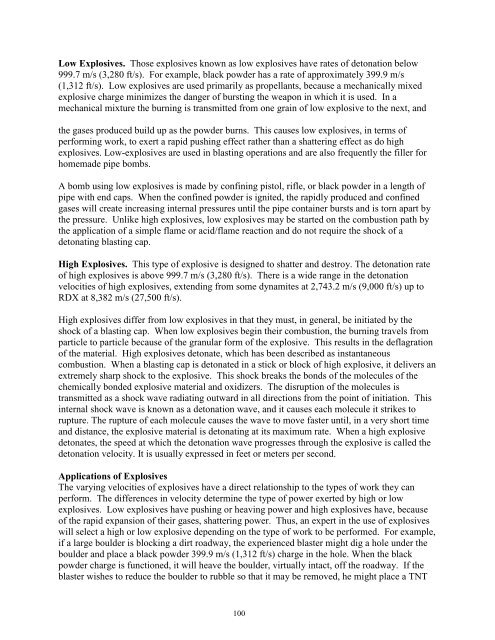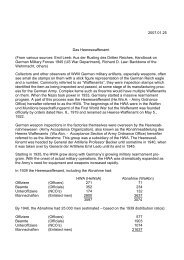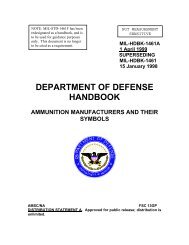Explosives-Nature, Use, Effects and Application.pdf
Explosives-Nature, Use, Effects and Application.pdf
Explosives-Nature, Use, Effects and Application.pdf
You also want an ePaper? Increase the reach of your titles
YUMPU automatically turns print PDFs into web optimized ePapers that Google loves.
Low <strong>Explosives</strong>. Those explosives known as low explosives have rates of detonation below<br />
999.7 m/s (3,280 ft/s). For example, black powder has a rate of approximately 399.9 m/s<br />
(1,312 ft/s). Low explosives are used primarily as propellants, because a mechanically mixed<br />
explosive charge minimizes the danger of bursting the weapon in which it is used. In a<br />
mechanical mixture the burning is transmitted from one grain of low explosive to the next, <strong>and</strong><br />
the gases produced build up as the powder burns. This causes low explosives, in terms of<br />
performing work, to exert a rapid pushing effect rather than a shattering effect as do high<br />
explosives. Low-explosives are used in blasting operations <strong>and</strong> are also frequently the filler for<br />
homemade pipe bombs.<br />
A bomb using low explosives is made by confining pistol, rifle, or black powder in a length of<br />
pipe with end caps. When the confined powder is ignited, the rapidly produced <strong>and</strong> confined<br />
gases will create increasing internal pressures until the pipe container bursts <strong>and</strong> is torn apart by<br />
the pressure. Unlike high explosives, low explosives may be started on the combustion path by<br />
the application of a simple flame or acid/flame reaction <strong>and</strong> do not require the shock of a<br />
detonating blasting cap.<br />
High <strong>Explosives</strong>. This type of explosive is designed to shatter <strong>and</strong> destroy. The detonation rate<br />
of high explosives is above 999.7 m/s (3,280 ft/s). There is a wide range in the detonation<br />
velocities of high explosives, extending from some dynamites at 2,743.2 m/s (9,000 ft/s) up to<br />
RDX at 8,382 m/s (27,500 ft/s).<br />
High explosives differ from low explosives in that they must, in general, be initiated by the<br />
shock of a blasting cap. When low explosives begin their combustion, the burning travels from<br />
particle to particle because of the granular form of the explosive. This results in the deflagration<br />
of the material. High explosives detonate, which has been described as instantaneous<br />
combustion. When a blasting cap is detonated in a stick or block of high explosive, it delivers an<br />
extremely sharp shock to the explosive. This shock breaks the bonds of the molecules of the<br />
chemically bonded explosive material <strong>and</strong> oxidizers. The disruption of the molecules is<br />
transmitted as a shock wave radiating outward in all directions from the point of initiation. This<br />
internal shock wave is known as a detonation wave, <strong>and</strong> it causes each molecule it strikes to<br />
rupture. The rupture of each molecule causes the wave to move faster until, in a very short time<br />
<strong>and</strong> distance, the explosive material is detonating at its maximum rate. When a high explosive<br />
detonates, the speed at which the detonation wave progresses through the explosive is called the<br />
detonation velocity. It is usually expressed in feet or meters per second.<br />
<strong>Application</strong>s of <strong>Explosives</strong><br />
The varying velocities of explosives have a direct relationship to the types of work they can<br />
perform. The differences in velocity determine the type of power exerted by high or low<br />
explosives. Low explosives have pushing or heaving power <strong>and</strong> high explosives have, because<br />
of the rapid expansion of their gases, shattering power. Thus, an expert in the use of explosives<br />
will select a high or low explosive depending on the type of work to be performed. For example,<br />
if a large boulder is blocking a dirt roadway, the experienced blaster might dig a hole under the<br />
boulder <strong>and</strong> place a black powder 399.9 m/s (1,312 ft/s) charge in the hole. When the black<br />
powder charge is functioned, it will heave the boulder, virtually intact, off the roadway. If the<br />
blaster wishes to reduce the boulder to rubble so that it may be removed, he might place a TNT<br />
100




